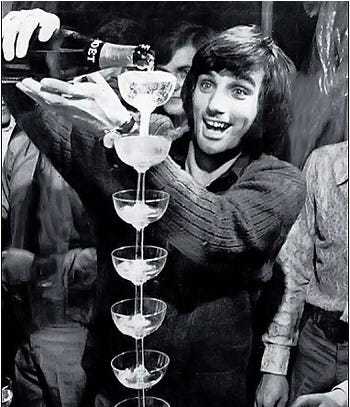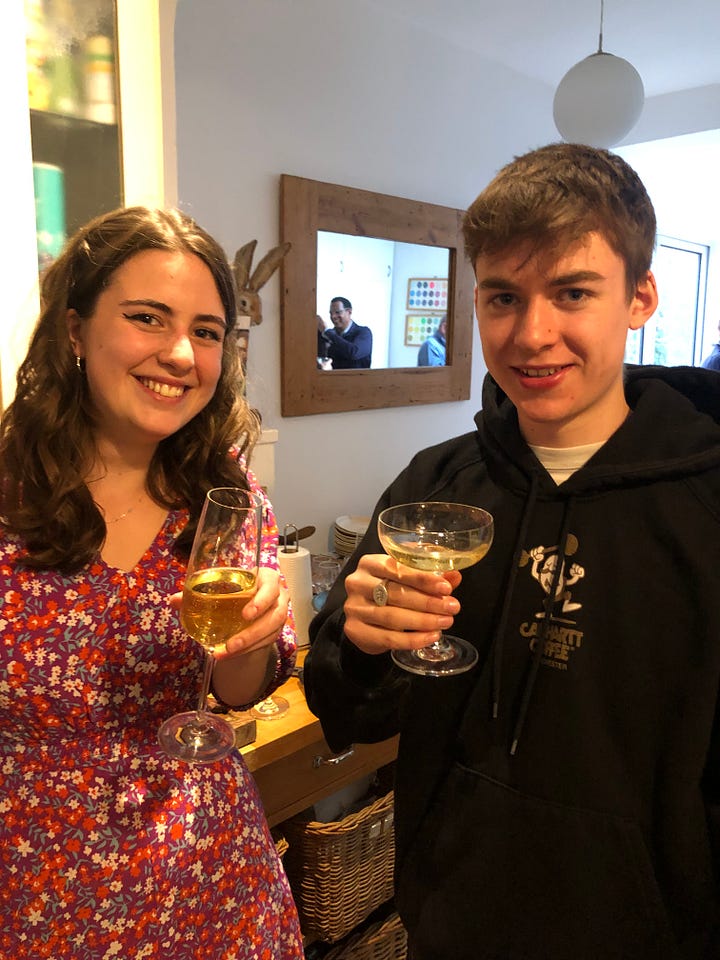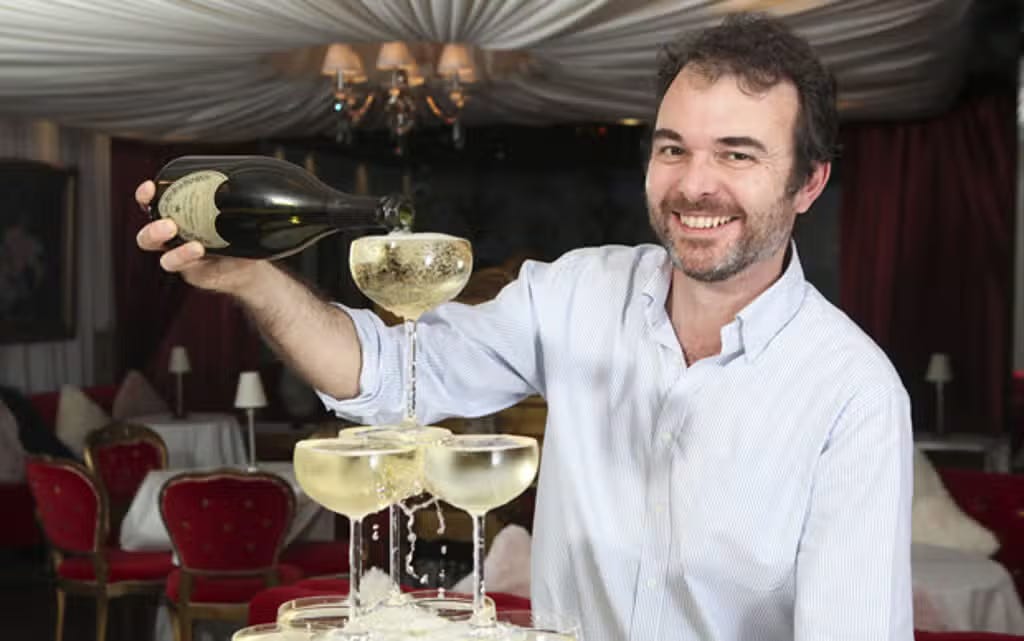The champagne glasses that say "party!"
Does it matter whether you serve bubbly from flutes or coupes? Plus: what I've been drinking recently


CELEBRATING a big wedding anniversary recently, I realised we’d need more champagne glasses for our guests than we possessed. A friend came to the rescue, saying he had several boxes. When I went around to pick them up, it turned out they were coupes. I was delighted.
Blame George Best, the legendary football star of my childhood. Best’s unpretentious hedonism – he later recalled that "I spent a lot of money on booze, birds and fast cars – the rest I just squandered” – was epitomised in the pictures of him filling up overflowing towers of champagne coupes. The working-class Belfast boy with England at his feet: it was the high life, 1960s and early-1970s style. Equally true, stemware-wise, for the Diamonds Are Forever-era James Bond: you wouldn’t catch Sean Connery with a fussy champagne flute.
The coupe’s moment didn’t last: since the 1970s they have become deeply unfashionable among champagne lovers, almost entirely replaced by tall, thin flute glasses. Certainly, setting out coupes for a champagne dégustation nowadays would be a faux pas on a par with farting in the tasting room, though presumably this wasn’t the case, at least for the coupes, in the 1920s.
Flutes keep the wine’s fizz longer: they cut down the speed at which the bubbles escape your glass, since the surface area of wine exposed to the air is smaller. Wine in a coupe also warms up quicker than in a flute.
Few party guests are going to critique the temperature of the bubbly in their glasses like the wine critics with whom I once attended the launch of a high-end cuvée at the Ritz Hotel in London, where we were served half a dozen glasses in succession all separated by a degree of temperature. But you certainly don’t want warm champagne.
Yet flutes aren’t really so functional if you’re tasting a champagne properly. I always taste champagnes from an ordinary wine glass: they’re much easier to swirl the wine in and judge its aromas properly.
Just to make sure, after my wedding anniversary party I tested all three glass shapes with a bottle of Romain Tribaut Grand Cru, a non-vintage Blanc de Blancs. First I tasted from an ordinary glass: nice brioche notes on the nose and palate, fresh acidity. Then the flute, which seemed to concentrate the mousse a little, while the nose was slightly less pronounced. And finally the coupe, in which the wine showed markedly less aroma on the nose. I’ll stick with an ordinary wine glass for tasting.
In fact, the different glasses are an example of the central role of fashion in wine. Flutes and coupes both date back to the eighteenth century, indeed before champagne was recognisable in its present form at all (until then it was mostly still and a light pink colour.) Their relative rise and fall over the years is almost entirely down to fashion: principally, what looks classier?
According to leading glassware manufacturer Riedel, however, the recent shift to flutes took place in part because of the rising price of champagne from the 1950s, as producers pushed to make it a more luxury product. Flutes allow for a more measured – and smaller – pour. And so they have now become synonymous with celebration.
But could coupes be due a comeback? “Coupes have not died out,” says Daniel Primack, Managing Director of stemware specialist Winerackd. “They’re extremely fashionable amongst the Gen Z and millennials who still actually drink.” (As in clothing, I would emphasise that my apparently fashionability in this respect is entirely unwitting.)
So it seemed, in fact, as long ago as 2012, when as the London Evening Standard’s wine critic, I was given the chance to build a 42-glass champagne-coupe tower at an unspeakable Mayfair night club patronised by rich eurotrash. Their floor-to-ceiling wine fridges offered Salmanazars (12 litres/nine bottles equivalent) of Armand de Brignac champagne in metallic gold bottles – the perfect gesture for those Russian oligarch-brats so insecure that even a Cristal-filled coupe tower (£10,000) didn’t seem enough of a statement.
After we’d started pouring the tower with a bottle of Dom Perignon and confirmed to the club’s owner that yes, we really did need to fill the whole thing for the photo, he gave us cava to fill the rest; I just posed with the DP bottle (after I and the photographer had polished off most of it). Fleet Street’s unwavering commitment to journalistic truth and its appetite for free booze can make uneasy bedfellows.
So: ultimately your choice of glasses for any sparkling wine depends a bit what you’re serving and who you’re serving it to.
The coupes experience that sticks in my mind is of legendary Barcelona tapas bar El Xampanyet, rammed on a Friday night, with waiters pushing through the crowd sloshing cheap cava into customers’ coupes. A bit less serious and somehow a bit more decadent than flutes - and frankly, with what they were serving, nobody was wishing they could get a better nose of the wine. Of course, the Wine Society’s Champagne Brut that we drank at our party in April was a lot better than that – but I still liked the coupes vibe.
But for serving more serious champagne in general? While I’d rather drink it from a wine glass, I have to admit that that probably isn’t going to say “party” to my guests. So I suppose I’d revert to flutes. See? It turns out I’m just as big a victim of fashion as the next wine drinker.

What I’ve been drinking recently
Majuelos de Callejo 2020, Ribera del Duero - I’ve written before about Bodegas Félix Callejo, one of my favourite Ribera producers and part of the new generation of terroir-focussed - and organic - producers. This cuvée is from a single vineyard at around 900 metres, all Tinto Fino (ie Tempranillo): complex, savoury, elegant and long - a very serious Ribera (ca €30 ex-cellar, where I got mine; N/A UK. The slightly more junior but very good Parajes del Callejo is at Virgin Wines, Barrique Fine Wines, Thorne Wines and elsewhere, from £26.95.)
Bodegas O’Ventosela, Viña Leiriña Mencía 2019, Ribeiro - Mencía, the main red grape of Spain’s north west, is usually associated with the Bierzo denominación, but they do grow it further west in Galicia too, towards the Atlantic coast, as in Ribeiro. This boasts classic fresh red fruit but with a savoury edge, nice balance and some depth too - and yet somehow it’s only 11.5 per cent alcohol. A steal while it’s on offer at Roberson (currently reduced to £10.98.)
Thymiopoulos Xinomavro Jeunes Vignes 2022, IGP Macedonia - Apostolos Thymiopoulos has done more than any other figure in the Greek wine world over the past few years to build the reputation of Greece’s greatest red grape, the North’s Xinomavro. This bursts with red fruit and characteristic tomatoey and herbal notes, with nice weight and balance - very moreish. This is one of my go-to reds and at £13.50 from the Wine Society, good value - though last week I drank it at brilliant neighbourhood Greek joint Evi’s, in East Dulwich, south London (The Wine Society, Wine and Greene, from £13.50. Shelved Wine have the 2021.)
Transparency note: I tasted at Bodegas Callejo in 2023 as a guest of the producer.




In the Champagne region you will often find these "Blida" style beakers used. As champagne is ubiquitous at every event, no matter how small, they prefer these functional, less fragile, smaller, glasses https://www.grande-cuvee.fr/produit/les-6-blidas-9-cl/
What they are telling us now in Germany is that we should serve our sparkling wine in a "Champagner-Glas," i.e. a special glass for sparking wine which is more slender than a normal white wine glass but fatter and rounder than champagne flutes. Naturally, I have these :-)
But at my wine tastings I serve the sparkling wine in normal white wine glasses. A few guests have commented, none has objected.